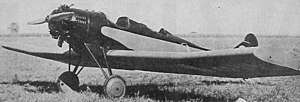Nicholas-Beazley NB-3
| NB-3 | |
|---|---|
 | |
| Barling NB-3 | |
| Role | Sport trainer |
| National origin | United States |
| Manufacturer | Nicholas-Beazley Airplane Company |
| Designer | Walter Barling |
| First flight | February 1928 |
| Number built | 20 |
| Unit cost |
$3,600 in 1930 |
The Nicholas-Beazley NB-3, or Barling NB-3, is a two seat, training aircraft of the 1920s.
Design
The Barling NB-3 was designed by Walter Barling in 1927. The aircraft was advertised as being able to right itself from any position with hands off the controls and also as being spin-proof.[1] The NB-3 is a low wing tandem-seat, open cockpit aircraft with conventional landing gear. The fuselage was constructed of welded chrome-moly steel tubing with aircraft fabric covering. The wings used a unique double layered corrogated aluminum skin with a smooth exterior that required custom presses to handle the various thicknesses of material along the span. The center section was straight with dihedreal in the outer bays. The spar was also aluminum with a U shaped profile. The aircraft was powered by an Anzani 3 cylinder radial engine, Superior radial or LeBlond 60-5-D.[2] The main gear used long struts attached to the upper fuselage for the largest landing gear geometry. The NB-3 fuselage was widened, giving one cockpit a side-by side seating arrangement to accommodate 3 people. The new aircraft was named the NB-4.[3]
Operational history
The NB-3 was test flown by Claude Sterling in February 1929. The plane competed in the 1929 National Air Races, placing first or second in events in its class. The Marshall Flying School advertised the NB-3 as a one-day-to-learn-to-fly aircraft with students flying in the morning, an aerodynamics class, learning how to weld by mid afternoon, salesmanship, and a leisure round of boxing and swimming by evening.[4][5] A NB-3 is on display at the N-B plant's hometown airport in Marshall, Missouri.[6]
Variants
- NB-3
- 60 hp (45 kW) Anzani powered - 3 built[7]
- NB-3G
- Armstrong-Siddely Genet Mk II 80 hp (60 kW)
- NB-3L
- Lambert 90 hp (67 kW)
- NB-3V
- Velie M-5 60 hp (45 kW) 1 built
- NB-4G
- Side-by-side variant with Armstrong-Siddely Genet Mk II 80 hp (60 kW)
- NB-4L
- Side-by-side variant with Lambert 90 hp (67 kW). ATC#365 issued 12-13-1930[8]
- NB-4W
- Side-by-side variant with Warner 90 hp (67 kW). ATC#386 issued 12-13-1930
Specifications (NB-3)
Data from Aeronautics
General characteristics
- Crew: 1
- Capacity: 1
- Length: 21 ft 11 in (6.68 m)
- Wingspan: 32 ft 9 in (9.98 m)
- Airfoil: Barling 90-A
- Powerplant: 1 × Anzani , 60 hp (45 kW)
- Propellers: 2-bladed
Performance
- Maximum speed: 87 kn; 161 km/h (100 mph)
- Cruise speed: 74 kn; 137 km/h (85 mph)
- Stall speed: 52 kn; 97 km/h (60 mph)
See also
References
| Wikimedia Commons has media related to Nicholas-Beazley NB-3. |
- ↑ Aeronautics: 5. January 1930. Missing or empty
|title=(help) - ↑ "NB-3". Retrieved 17 February 2012.
- ↑ Popular Aviation: 15. June 1931. Missing or empty
|title=(help) - ↑ Aeronautics: 55. January 1930. Missing or empty
|title=(help) - ↑ Aeronautics: 69. September 1929. Missing or empty
|title=(help) - ↑ "Nicholas-Beazley Aircraft Company Museum". Retrieved 17 February 2012.
- ↑ "The Nicholas-Beazley Airplane Company". AAHS Journal. Summer 1992.
- ↑ Joseph P. Juptner. U.S. civil aircraft, Volume 4. p. 264.